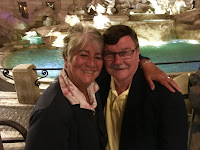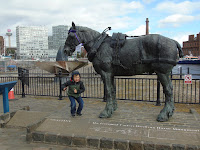After a stressful seven months for Fred and myself due to illness we are back to some travel and take a mini break to Lincoln taking advantage of point we have collected thru Mecure Hotel chain. Two nights allow us to see some National Trust sites we have not explored. On our way to Lincoln we stop at The Workhouse, Southwell. Built in 1824 and was the prototype of the 19th century workhouse. It was a sanctuary of sorts of the destitute . Families
 come to the workhouse and where separated into segregated groups. Men, women and children. Residents were given shelter, clothes and food. They were expected to find work and better themselves if at all possible. There was no separation for the mentally ill or infirm and the conditions to us seem rather cruel, separating families and having them work for food, clothing and shelter. However the alternative in the time was probably far worse. The workhouse was in use right up to the 1980's where it was used to provide temporary shelter for women with children. The picture on the right is of the communal kitchen that was set up in the room that families would share in 1960. It is unbelievable to us that this would still be needed at this time. Now the property of The National Trust it is the best preserved workhouse in England.
come to the workhouse and where separated into segregated groups. Men, women and children. Residents were given shelter, clothes and food. They were expected to find work and better themselves if at all possible. There was no separation for the mentally ill or infirm and the conditions to us seem rather cruel, separating families and having them work for food, clothing and shelter. However the alternative in the time was probably far worse. The workhouse was in use right up to the 1980's where it was used to provide temporary shelter for women with children. The picture on the right is of the communal kitchen that was set up in the room that families would share in 1960. It is unbelievable to us that this would still be needed at this time. Now the property of The National Trust it is the best preserved workhouse in England.We have supper at the Swanholme Tavern Pub. We are lucky to get a table as the place is extremely busy. Our waitress Abbey in amazing as she is run off her feet serving tables and yet finds time to ensure everything is all right and if we require anything else. The food is very good and arrives in a timely manner considering how busy it is. Fully satisfied we head back to the hotel for a nights rest before setting off to explore more sites.
Aug 29th we head out to explore two sites. Our first stop is Tattershall Castle was originally a fortified manor house built by Robert de Tattershall in 1231. This was largely rebuilt in brick and greatly expanded by Ralph 3rd Lord Cromwell, Treasurer of England between 1430 and 1450. Brink castles were less common in England and were chosen for their aesthetic appeal or because it was fashionable. 700,000 bricks were used in the building of the castle but all that remains today is the tower and moat. A large amount of the destruction happened during the civil war. After 200 years of abandonment and ruin the castle was saved from demolition and restored to its current state by Lord Curzon between 1911-1914. He left it to the National Trust on his death in 1925 and remains one of the 3 most important brick castles of the mid 15th century. We are able to explore all the floors of the castle except the very top turrets which were closed for renovation. The stairs were nice and wide and gradually went up unlike some narrow steep steps we have experience in other castles. More pictures are available on my Facebook wall.
Our next stop is Belton House a Grade I listed country house built
 between 1685 and 1688 by Sir John Brownlow,3rd Baronet. It has been described as a typical English country house. It remained in the Brownlow family until 1984 when it was donated to The National Trust. The use and design of the interior rooms changed over the generations.
between 1685 and 1688 by Sir John Brownlow,3rd Baronet. It has been described as a typical English country house. It remained in the Brownlow family until 1984 when it was donated to The National Trust. The use and design of the interior rooms changed over the generations.The house also had its own Chapel on the main floor for the family and servant's to worship on the Lord's Day. We spend a good couple of hours exploring the house and gardens . The grounds are quite extensive but we only due the immediate gardens attached to the house and the Orangery. The grounds have a circular walk of 3 kilometres that take in the gardens ,pleasure grounds and lake however we just do the gardens as it now late in the day and the sky looks threatening. Once again check out my Facebook wall for further pictures.
Aug 30 we head home with a stop at Hardwick Hall a Elizabethan Country House built between 1590 and 1597 for Bess of Hardwick .
Bess was the richest women in England at the time after Queen Elizabeth I, growing in wealth thru 4 marriages. I found her history very intriguing as she was described as shrewd, manly especially by her fourth husband the Earl of Shrewsbury . The were estranged for most of the marriage until his death n 1590. She remained one of the richest and powerful women in England until her death at the age of 81 in 1608. The hall is home to some beautiful tapestries that Bess herself worked on with Mary Queen of Scots .
Pictured on the left is a Appliqué Embroidery from 1573.
The Hall remained in the family until 1950 when the unexpected death of the 10th Duke of Devonshire. Properties were handed over the The
National Treasury in lieu of death taxes. The Duchess of Devonshire the widow of the 9th Duke was living at Hardwick and remained so until her death in 1960 where she did much tp preserve the tapestries and conservation on the house itself. The treasury handed over the house to The National Trust in 1959 . We continued our trip via backroads home until we hit Manchester where the traffic is one massive traffic jam. Pictures of rooms and furniture of Hardwick Hall are on my Facebook wall.
Till our next adventure,
Sandy & Fred
























































